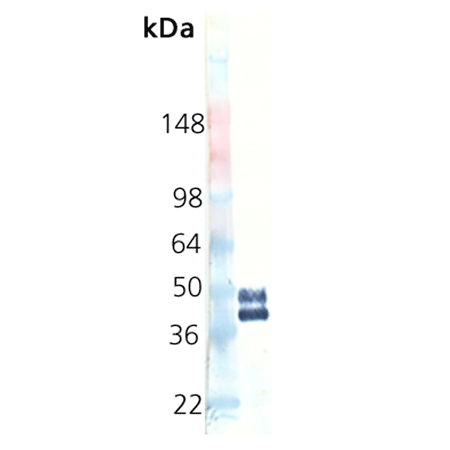Product Details
| Alternative Name: | Programmed cell death-1, CD279, Programmed death receptor 1 |
| |
| MW: | ~20.5kDa (actual is a doublet at 40kDa and 50kDa that is immunoactive with PD-1) |
| |
| Source: | Produced in HEK cells. Extracellular domain of PD-1 (aa 25-167) containing a 5’-His-tag, V5 epitope tag spacer, and a FLAG-tag. |
| |
| UniProt ID: | Q15116 |
| |
| Formulation: | Lyophilized. Contains PBS. |
| |
| Purity: | ≥90% (SDS-PAGE) |
| |
| Endotoxin Content: | <100 EU/mg |
| |
| Biological Activity: | Binds to PD-L1. |
| |
| Shipping: | Blue Ice Not Frozen |
| |
| Long Term Storage: | -20°C |
| |
| Handling: | Avoid freeze/thaw cycles. After reconstitution, prepare aliquots and store at -80°C. |
| |
| Scientific Background: | PD-1 (programmed cell death-1) is a transmembrane protein important for regulating immune responses. It is a member of the CD28/CTLA-4 family of immunoreceptors and is expressed on T cells and pro-B cells suggesting it has a broad spectrum of immune regulation. PD-1 along with its two ligands, PD-L1 and PD-L2, prevent the activation of T cells and protect tissues from autoimmune attack. PD-1 and its ligands are also involved in reduction of infectious immunity, as well as tumor immunity. PD-1 has been shown to facilitate chronic infection and tumor progression. Drugs targeting PD-1 have shown promise in treating cancer and HIV and may be important in a variety of immune related disorders. |
| |
| Technical Info/Product Notes: | FLAG is a registered trademark of Sigma-Aldrich Co. |
| |
| Regulatory Status: | RUO - Research Use Only |
| |

PD-1 Activity. PD-1 activity is in the range of 100 – 25,000 ng/ml. This was done by measuring PD-1’s ability to bind to human PD-L1 (B7-H1) that was immobilized onto magnetic beads. Briefly, PD-1 was titered into the assay, which contained PD-L1 coated magnetic beads and goat anti – human PD-1 conjugated to phycoerythrin (PE). The reactions were incubated for 1 hour at room temperature, washed 3X with PBS, and resuspended in PBS. Each reaction was analyzed by measuring median PE intensity on a BD FacsCalibur cytometer.

Western Blot Analysis. Lane 1, Molecular weight marker. Lane 2, 100ng PD-1. Probed with mouse anti-PD-1 monoclonal antibody.

Coomassie stained SDS-PAGE. Lane 1, Molecular weight marker. Lane 2, 1.0 µg PD-1.

Western Blot Analysis. Lane 1, Molecular weight marker. Lane 2, 100ng PD-1. Probed with rabbit anti-FLAG polyclonal antibody.
Please mouse over
Product Literature References
A new catalytic site functioning in antigen cleavage by H34 catalytic antibody light chain: E. Hifumi, et al.; Sci. Rep.
12, 19185 (2022),
Abstract;
General Literature References
PD-1 pathway inhibitors: changing the landscape of cancer immunotherapy: D.E. Dolan, et al.; Cancer Control
21, 231 (2014),
Abstract;
Full Text
Programmed death-1-induced interleukin-10 production by monocytes impairs CD4+ T cell activation during HIV infection: E.A. Said, et al.; Nat. Med.
16, 452 (2010),
Abstract;
Full Text
The PD-1 pathway in tolerance and autoimmunity: L.M. Francisco, et al.; Immunol. Rev.
236, 219 (2010),
Abstract;
Full Text
CTLA-4 and PD-1 receptors inhibit T-cell activation by distinct mechanisms: R.V. Parry, et al.; Mol. Cell. Biol.
25, 9543 (2005),
Abstract;
Full Text
Involvement of PD-L1 on tumor cells in the escape from host immune system and tumor immunotherapy by PD-L1 blockade: Y. Iwai, et al. ; PNAS
99, 12293 (2002),
Abstract;
Full Text
Engagement of the Pd-1 immunoinhibitory receptor by a novel B7 family member leads to negative regulation of lymphocyte activation: J.F. Gordon, et al.; J. Exp. Med.
192, 1027 (2000),
Abstract;
Full Text
Related Products
















